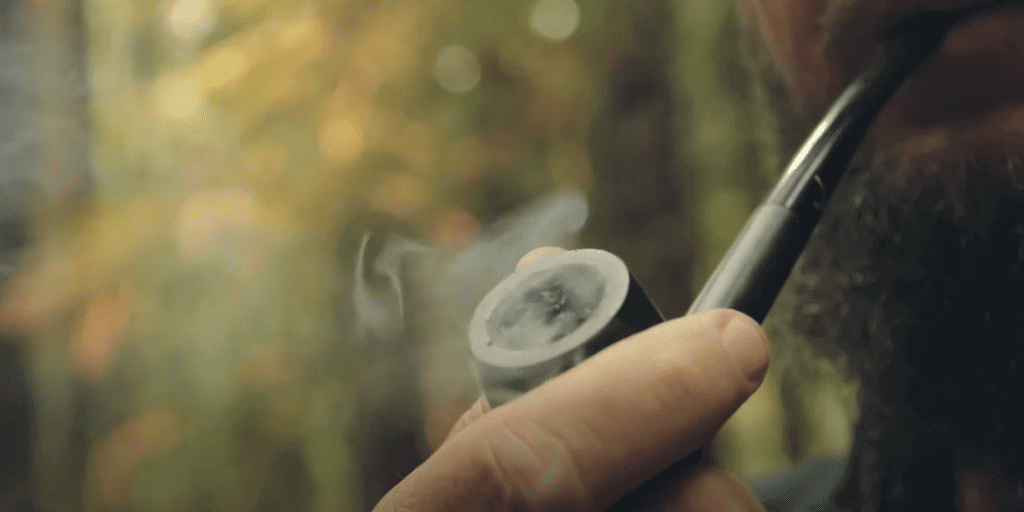Pipe tobacco is a type of smokeless tobacco that is known for its high nicotine content. It can be purchased in bulk and then stored for later use, but it will still dry out over time. When this happens, it becomes difficult to enjoy your tobacco pipe without having to deal with the harshness of dried-out tobacco. The good news is that rehydrating your pipe tobacco only takes a few minutes!
It’s easy to rehydrate your pipe tobacco with these simple steps! It can be difficult to find the perfect moisture level for your pipe tobacco, but don’t worry because now there are tips and tricks for how to rehydrate it.
Table of Contents
Why Dry Tobacco is Not Ideal: The Facts & Production Process
- When a cigar or a pipe is first lit, the tobacco begins to burn and release smoke that carries its unique flavor. The reason why cigars taste so good when you light up one after another is their moisture content. If they burned at their ideal humidity level (between 60% – 70%) there would be no need for this process;
- When you dry tobacco, the fluids evaporate and it becomes too crispy to smoke. The oils that are associated with cigars or pipe tobaccos will separate from one another as well because of this process;
- You could light a cigar without first cutting off its head (the end where the cap is placed) but it would be very difficult for you to draw on since all those flavors we were talking about earlier? Well they’ll get caught up in your throat rather than going into your mouth which is what everyone wants. If there was no moisture inside a cigar then nobody would buy them! That’s why drying these products out isn’t an ideal way of smoking them – you’re losing everything that makes their taste so unique;
Optimal Moisture for Pipe Tobacco
Pipe tobacco should have a moisture content of between 18 percent and 22 percent. That implies that if you weigh a sample of tobacco, bake all of the moisture out, then reweigh it, the finished product will be 18 percent to 22 percent lighter than before [1].
To put this another way, if you weigh a pipe tobacco sample before you smoke it and again after drying it for 24 hours in an oven set at no more than 110F, the weight will be roughly one fifth of what it was previously. For example, if you had 100 grams of moist tobacco before smoking (and therefore after drying) then after smoking that amount would only be 20 grams.
When buying new loose blends or tins from your local tobacconist they should have approximately 18 percent water content by volume according to some manufacturers. This is why most people choose to let their newly bought blend sit open on their counter so air can reach all parts of the product itself that speeds up its rehydration process.
How Moisture Affects Flavor?
- When drying tobacco takes place, the flavors are being burned off which is why it’s important to maintain that 18-22% moisture level. If you’re unable to do this then your cigar will taste less flavorful than before even if it does burn at its ideal humidity point! Those oils aren’t just going to disappear so don’t think they have no idea what they’re doing;
- If you dry out a blend too much or for too long, there isn’t enough water left in the leaf, and combustion becomes difficult. The smoke can be harsh due to incomplete burning of sugars and other organic components along with resins;
- You might also find that when smoking cigars or pipe tubes after dehydration that there’s less of a smell to them than before. They won’t produce as much smoke either which is another reason why you might not like smoking these after they’re dried out for too long;
- On the other hand, if there’s still too much moisture inside your tobacco then it can “gum up” which means that it will clog up your pipe or make life difficult in general when trying to enjoy one of these products. It’ll burn too hot and again – lose all those flavors we were talking about earlier! You don’t want to be stuck with something like this so do yourself a favor and rehydrate any dry blend you have on hand today;
How to Maintain Moisture Levels?
The best way to maintain these moisture levels is to store your pipe tobacco in a humidor. If you’re not able to do this then it’s important that you make sure they are stored somewhere cool and dry like on an open bookshelf or even under the bed (this might sound odd but there are some people who swear by this method).
You can also use regular cigar humidifiers that work great for maintaining humidity at 70% whereas testing kits will help keep track of both temperature and humidity so you don’t have too much going out of whack while trying to enjoy one of these products.
Another option if you want something more stylish would be a glass jar with a sealable lid where you’ll add either mineral water, propylene glycol, or distilled water. A small piece of cotton wool will do the trick in absorbing excess moisture and then you’ll want to open your jar every couple of days for a few hours at a time to let that moist air escape into the environment.
How To Rehydrate Pipe Tobacco Guide
Rehydrating with Heat
- Fill a vacuum-sealed jar halfway with the heated fruit, then seal. Put the tobacco in a stainless steel salad bowl;
- Using a spray bottle, wet the tobacco and spray a fine mist over it 3-4 times;
- With a spoon or spatula, mix the tobacco;
- Place the tobacco in a large jar with a vacuum-seal rubber-gasket lid that screws down and has a sealable plastic top;
- Place the jar in an oven preheated to 200 F for 20 minutes, or until it is warm to the touch. Allow ten minutes for chilling;
- Remove the jar after it has cooled overnight in a cool, dry location. Don’t open it until the next day;
- Make sure to stuff the tobacco firmly down and close the lid securely [2];
Hydrating with Food Products
An easy method of rehydrating pipe tobacco that’s been dried out too much is by adding some apple slices or an apple pie filling into the jar with it. You can also use canned peaches, pears, cherries (especially cherry pie filling), peach jam/preserves, pineapple preserves, pear preserves, and more like this well:
- Simply add about one tablespoon of fruit per ounce of tobacco in the container you want to keep it in. You could even mix different types together if you wanted;
- Then seal up the lid on your jar and let sit at room temperature for 24 hours before sealing tightly;
- After 48 hours have passed, open up the jar to let the dehumidifying process begin;
- At this point what’s left in the bottom are little droplets of water that have accumulated over about three days’ worth of sitting close together with all those fruits or jams inside;
- Now seal everything back into place once more until two weeks later when you’ll want to start smoking it as usual;
Moistening with a Damp Product
Another method of rehydrating your pipe tobacco that has been dried out too much is by adding a damp product to it. People sometimes choose this way because they want the flavor and aroma of the specific foodstuff without actually having to add any kind of fruit or preserves into their jar with it. Instead, you could use:
- something like vodka;
- rum (use only 80 proof);
- apple juice (not from concentrate);
- orange juice (concentrate works fine);
- watermelon extract;
- peach nectar;
- pineapple juice;
- buttermilk;
Tips for users: always pour in one teaspoon per ounce of tobacco and seal up for 48 hours before opening again at room temperature until two weeks later when you’ll be able to smoke your favorite blend once more.
The Steam Iron Method
In order to rehydrate your pipe tobacco using this technique, all you have to do is:
- Lay a sheet of aluminum foil on top of your countertop or table then place your dried-out tobacco onto that sheet in an even layer;
- Using a household iron set at medium heat turn off its steam function while carefully positioning the bottom part just above the pile of dry tobacco – but not touching anything;
- Place another piece of aluminum foil over the entire thing (iron included) and secure with tape if necessary before leaving everything alone until the next morning when taking away from it;
- You can now stuff your tobacco into a pipe or place it back inside its pouch and jar if that’s what you’d prefer to do with it. Smoke well;
Storing Herbs/Pipe Tobacco the Right Way
Tupperware and Plastic Containers
If you’re wondering how to properly store your herbs then Tupperware is definitely one of the best choices. A good alternative would be any kind of plastic container that has an airtight seal-type lid on it with a rubber ring built into it for creating tightness. Do not use glass jars because moisture will accumulate over time that could cause your storage place or jar’s lid itself to rust and ruin everything inside!
Plastic containers also help keep things fresh while preventing outside odors from infiltrating at all, especially if they have those lids mentioned above as well as foam padding underneath them too (for extra protection).
To prevent mildew and mold just make sure there are no holes in these types of tubs/containers before the first time you use them for storage purposes.
Mason Jar
When it comes to storing tobacco in a mason jar, the best choices would be either wide-mouthed or regular jars with glass lids for this purpose. You can also use any kind of plastic lid but make sure that there are no holes in them at all before using!
The reason why you should never store your dried, cured pipe tobacco inside Tupperware or Mason jar is that over time moisture will accumulate and break down its taste/flavor which means that within just one year’s time you could end up smoking something utterly disgusting instead. Instead, if stored correctly then each smoked bowl could last for about 2 years on average although many people choose to smoke their stash even faster than that anyway – especially when they are enjoying every puff too much to resist!
To prevent mold and mildew, place a tablespoon of either salt or baking soda in the bottom of your container (glass jar, plastic tub). Then add in the dried-out tobacco on top before sealing that lid tightly.
FAQ
What is a pipe tobacco profile?
A pipe tobacco profile is basically a list of all the different tobaccos used in order to make up that blend.
The term “profile” refers to the flavor, cut, and overall experience one can expect from smoking it – i.e., how much nicotine will be provided along with what kind of body/mouthfeel (which includes moisture) just as an example too!
There are many kinds but the most popular ones include English blends that contain Latakia leaves for smokiness while Oriental Blends have Turkish leaves instead plus Perique for spiciness. Virginia-based aromatics typically have bright yellow or orange ribbons mixed in with black Cavendish near the end before packing them into your favorite bowl [3].
Do you need to humidify pipe tobacco?
Yes, you should always keep your dried-out tobacco inside a humidor in order to prevent mold and mildew from damaging it. This also applies if you plan to store pipe tobacco for an extended period as well – perhaps even up to 6 months or so depending on the type!
A small amount (about 15-20%) of distilled water placed into a mason jar with the leaves is enough to give them just enough humidity without overdoing it either which can result in clumping/mushiness that won’t burn properly. If too much moisture causes those leaves to become slimy then remove them immediately before they make any contact because this will ruin everything else inside instead!
The tobacco absorbs flavors easily, especially when smoked later on, which is why you should never store it inside a container that used to contain anything else unless all traces of that previous smell are gone now. The reason for this is because the taste/smell will mix with whatever tobacco you put into there and ruin its original flavor instead.
Finally, if your jar smells like vinegar then moisture has gotten in (check seals) while mold would indicate too much humidity – either way, toss it right away!
Can pipe tobacco get too dry?
When tobacco is overly dry, the oils and flavor compounds in it can break down [4]. It’s simple to tell if tobacco is too dry because it disintegrates on contact and crumbles to dust, but if it’s overly wet, you may mold it into a ball without crumbling.
Should you keep tobacco in the fridge?
In a refrigerator, loose tobacco pouches can be kept. Keep in mind that even without any refrigeration, they will last for months. Unless it becomes wet, tobacco does not spoil. It is usually a personal choice whether or not to refrigerate tobacco items [5].
Does pipe tobacco get better with age?
Not really. Pipe tobacco is best when it’s fresh, and the flavors are at their peak. While some people will argue that aging changes pipe tobacco in ways that improve its flavor, most experts agree that this belief is a myth.
Tobacco leaves contain sugars that can ferment over time producing acids (which affect the taste) while heat speeds up these reactions too so storing them in extreme temperatures like direct sunlight or inside of your car for example should be avoided to keep the leaf from becoming stale instead.
How do you dry and cure tobacco at home?
There are a number of ways to dry and cure tobacco at home. One way is by hanging the leaves in a dark, well-ventilated room with low humidity for about two weeks until they become crispy.
Another way is placing them inside an oven set between 200F and 250F until it becomes crisp which usually takes about 30 minutes maximum depending on how much you have too! Make sure that your dried-out pipe tobacco has been completely cooled down before opening up any container or cellophane wrapper because this will allow oxygen into your jar/bag again making everything damp once more instead.
Finally, if all else fails then light microwaving can get rid of excess moisture but make sure not to use high levels as this can scorch the leaves and ruin them in a hurry instead.
If you have any leftover tobacco from your last smoke then it’s advised to keep that jar closed tightly so no air gets in because this will allow the flavors/aromas to stay preserved longer when keeping them inside of an empty mason or jam jar.
Is pipe tobacco safer?
Although the danger of dying from tobacco-related illnesses is lower for pipe smokers than for cigarette smokers, pipe smoking is just as harmful as, and perhaps more so than, cigar smoking [6].
Useful Video: Rehydrating Your Pipe Tobacco Like a Boss
References:
- https://www.smokingpipes.com/smokingpipesblog/single.cfm/post/proper-pipe-tobacco-humidification
- https://www.wikihow.com/Rehydrate-Stale-Tobacco
- https://www.bespokepost.com/the-post/a-beginners-guide-to-pipe-tobacco
- https://www.smokingpipes.com/smokingpipesblog/single.cfm/post/proper-pipe-tobacco-humidification
- https://windycitycigars.com/tobacco/can-you-refrigerate-tobacco
- https://academic.oup.com/jnci/article/96/11/853/2520796







